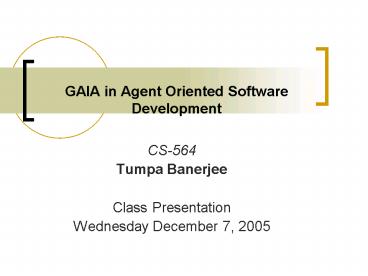GAIA in Agent Oriented Software Development PowerPoint PPT Presentation
1 / 28
Title: GAIA in Agent Oriented Software Development
1
GAIA in Agent Oriented Software Development
- CS-564
- Tumpa Banerjee
- Class Presentation
- Wednesday December 7, 2005
2
Topics
- Agent Oriented Software Development
- Multi Agent Software System
- GAIA Methodology
- Initial Limitations
- Overview of Gaia v.2
- Roadway
- References
3
Agent Oriented Software Development
- an agent is an encapsulated computer system that
is situated in some environment, and that is
capable of flexible, autonomous action in that
environment in order to meet its design
objectives - by Wooldrige
- Are Problem solving entities with well defined
boundaries and interfaces - Receive inputs to the state of that environment
through their sensors and they act on the
environment through their effectors - Designed to fulfill particular job
- Autonomous i.e. have control over their internal
state and behavior - Capable of exhibiting flexible behavior
4
Multi Agent Software System (MAS)
- Multi-agent system (MAS) is a system composed of
several agents, capable of mutual interaction.
The interaction can be in the form of message
passing or producing changes in their common
environment
Canonical view of a multi-agent system
5
GAIA Methodology
- Gaia - a methodology for agent oriented analysis
and design was introduced by 2000 by Michael
Wooldridge, Nicholas R. Jennings and David Kinny - Invented to start from requirement statements to
detailed design that can be implemented directly. - General
- wide range of multi-agent systems
- comprehensive
- macro-level (societal)
- micro-level (agent)
6
GAIA methodology
Relationship between GAIAs Model
7
GAIA methodology
8
GAIA methodology
Analysis concept
9
GAIA methodology (Analysis Concept)
- Analysis stage roles in the system identified
and interaction modeled. - Roles Abstract constructs used to
conceptualize and understand the system, with no
concrete counterpart in the implemented system - All roles are atomic which cannot be defined in
terms of other roles.
10
GAIA methodology (Analysis Concept)
- It gives semi formal description of the
behavior of the agent. - There are 4 attributes of Role
- Permission gives the environmental resources
available, generally specifying information as of
read, write or create - Responsibility it give the actual
functionality - Safety
- liveness
- Activity associated computations which can be
performed by a agent without interacting with
other agents - Protocol Its is the way in which it is should
interact with other roles.
11
GAIA methodology (Analysis Concept)
12
GAIA methodology (Analysis Concept)
13
GAIA methodology (Analysis Concept)
14
GAIA methodology (Design Concept)
- Agent Model documents various agent types that
will be used in the system development, and the
agent instances that are responsible for
recognizing the agent types during the run time - A
sample agent design
15
GAIA methodology (Design Concept)
- Service Model identifies the services
associated with each agent role, and specify the
main properties of the services. - Service has 4 attributes
- Inputs
- Outputs
- Pre-conditions
- Post-conditions
- Acquaintance model defines the communication
links that exists between agent types.
16
GAIA methodology (Design Concept)
- Overall Design process
- Create an agent Model
- Aggregate roles into agent types , and refine to
form an agent type hierarchy - document the instances of each agent type using
instance annotations. - Develop a services model, by examining
activities, protocols, and safety and liveness
properties of roles. - Develop an acquaintance model from the
interaction model and agent model.
17
Limitations
- designed to handle small-scale, closed
agent-based systems - Inappropriate in handling complex open systems
- Is not able to explicitly model and represent
important social aspects of multi-agent systems.
Specially it has problem with the system with
merely nonrecursive roles. Also assumes all
agents to be cooperative - Employs Gaia specific notations for representing
roles, which are poor in expressing complex
problems.
18
Overview of Gaia v.2
Requirements
Collection of requirements
Gaia Scope
Analysis
Subdivide System into sun Organizations
Environmental Model
Preliminary Role Model
Preliminary interaction Role Model
Organizational Rules
Design
Organizational Structure
Interaction Model
Organizational Patterns
Role Model
Agent Model
Service Model
Implementation
19
Overview of Gaia v.2
- Analysis phase
- Goals of the organizations and their expected
behavior - Identify decomposition between global and sub
organization - Environment Model where the multiagent systems
will be submitted - Preliminary Roles Model unlike Gaia , the
analysis has to avoid the imposition of specific
organizational structure implicitly defined via
the role model. - Preliminary interaction Model abstact away from
the organizational stucture - Organizational Rules which governs the
organization s global behavior.
20
Overview of Gaia v.2
- Design Phase
- Definition of overall architecture of the system
- Huge number of different organizational
structures a which opens up the opportunity to
exploit existing catalogs of the organization - Preliminary roles are revised and completed
- Define agent model specifying types
- Define service model (as in the original version)
21
Roadmap
- Started in 2002 ,Juan et al is an extension of
Gaia with dynamic hierarchy. - Models are added to explicitly describe the agent
environment and knowledge - Follows the basic underlying principle as Gaia
- Follow the organizational view on multiagent
systems and basic definitions
22
Roadmap
System viewed as a computational organization
made up of the role hierarchy and the agent
hierarchy
23
Roadmap
Message passing between agents via their roles
24
Roadmap
Re-routing interaction with protocols
25
Roadmap
26
Roadmap
The ROADMAP meta-model
27
Roadmap
Models in the Roadmap Methodology
28
References
- The Gaia Methodology for Agent-Oriented Analysis
and Design, - MICHAEL WOOLDRIDGE, NICHOLAS R. JENNINGS, DAVID
KINNY - THE GAIA METHODOLOGY BASIC CONCEPTS AND
EXTENSIONS - Luca Cernuzzi1, Thomas Juan2, Leon Sterling2, and
Franco Zambonell - A survey of Agent Oriented Software Engineering
- Amund Tveit
- Agent Oriented Software Engineering
- N.R. Jennings ,Michael Wooldridge
- Figures are mostly taken from the above mentioned
articles

